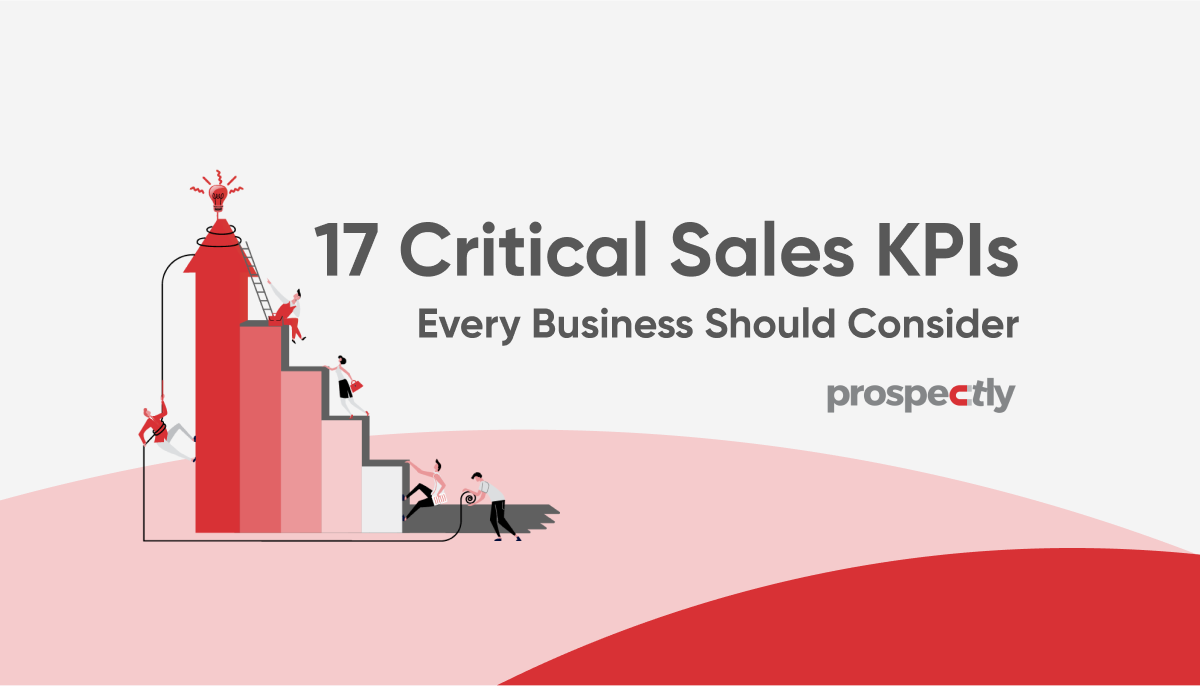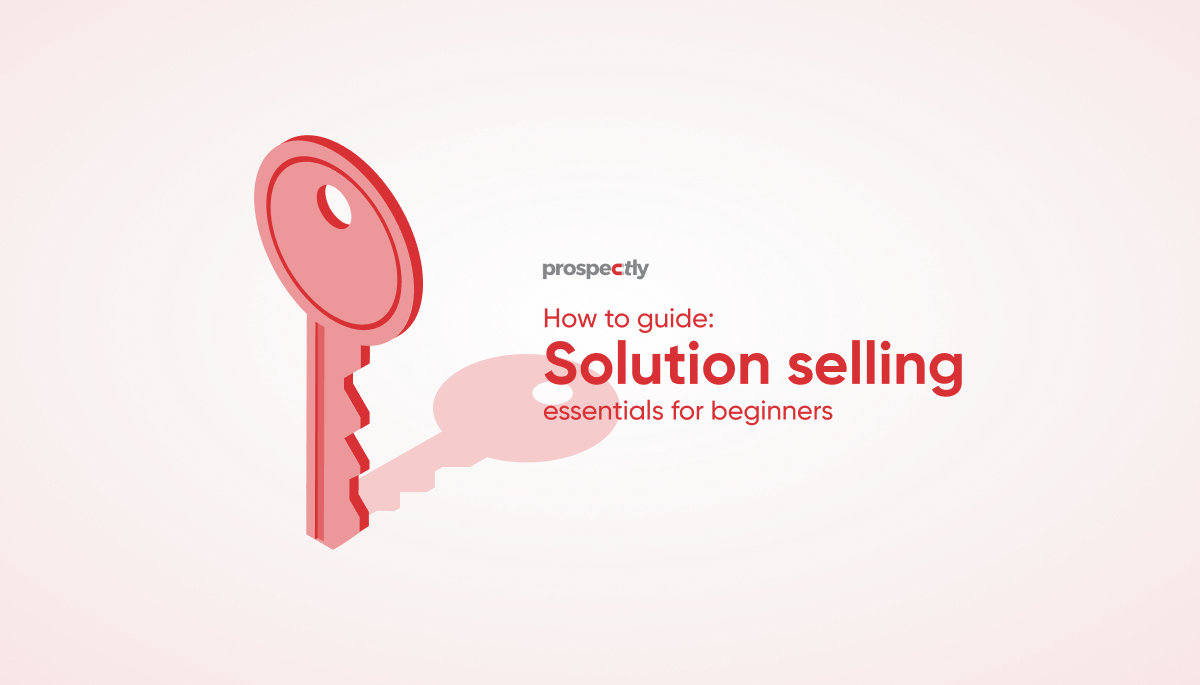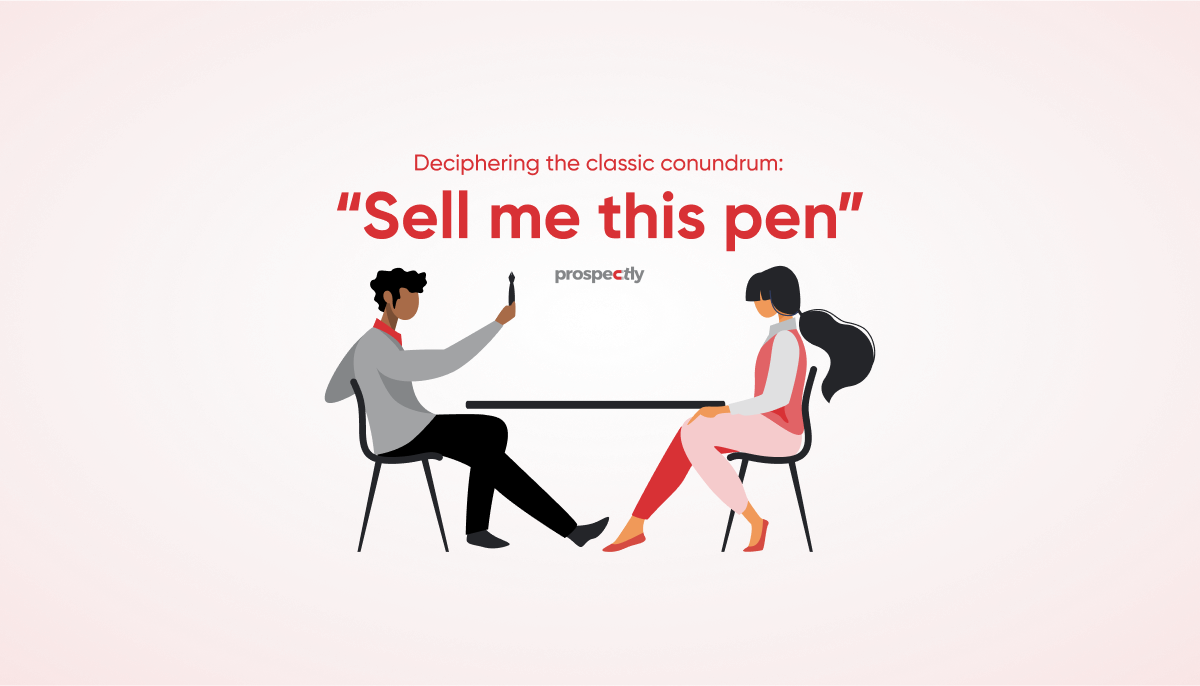11 creative ways to improve your sales presentation

A good sales presentation is what drives the deal. It’s what closes the deal and earns money. It should present the company’s product and service, its benefits to customers, and how it can solve their problems. A sales presentation is an integral part of any sales process, and a salesperson should always know how to make an effective sales pitch.
This section will provide valuable tips for creating a successful and persuasive sales presentation to help you close more deals with your clients.
Sales presentation definition
A sales presentation is a form of public speaking by sales personnel to pitch a product or service to potential customers. It persuades your prospect into buying your solution by educating them on what you offer and why they should buy it. It’s an essential part of the sales process and a tool to win potential buyers and close deals.
Sales pitch vs. sales presentation
A sales presentation is still a sales pitch but a more extended version requiring teamwork in preparation and delivery. A sales pitch is possible over the phone, email, or meeting. It’s what you do daily. But a proposal presentation targets a group of senior managers or executives in a public setting. It occurs after many touchpoints in your sales cadence and focuses on a more significant deal.
What should a sales presentation include?
A sales presentation is an interactive, visual, and persuasive communication method involving words, graphics, and other content. It should also include the following:
- PowerPoint presentations
- Video or live demonstration
- Testimonials
- Charts, quotes, graphs to strengthen your case
- Personalized content dealing with your audience’s challenges
- A call to action – the next step for the potential customer
What makes a good proposal presentation?
An effective sales presentation will have a clear objective, an introduction to the company and what they do, a demo or live demonstration of the product or service, testimonials from satisfied customers, and a call-to-action for the prospect to move forward with the purchase.
How to create a sales presentation?
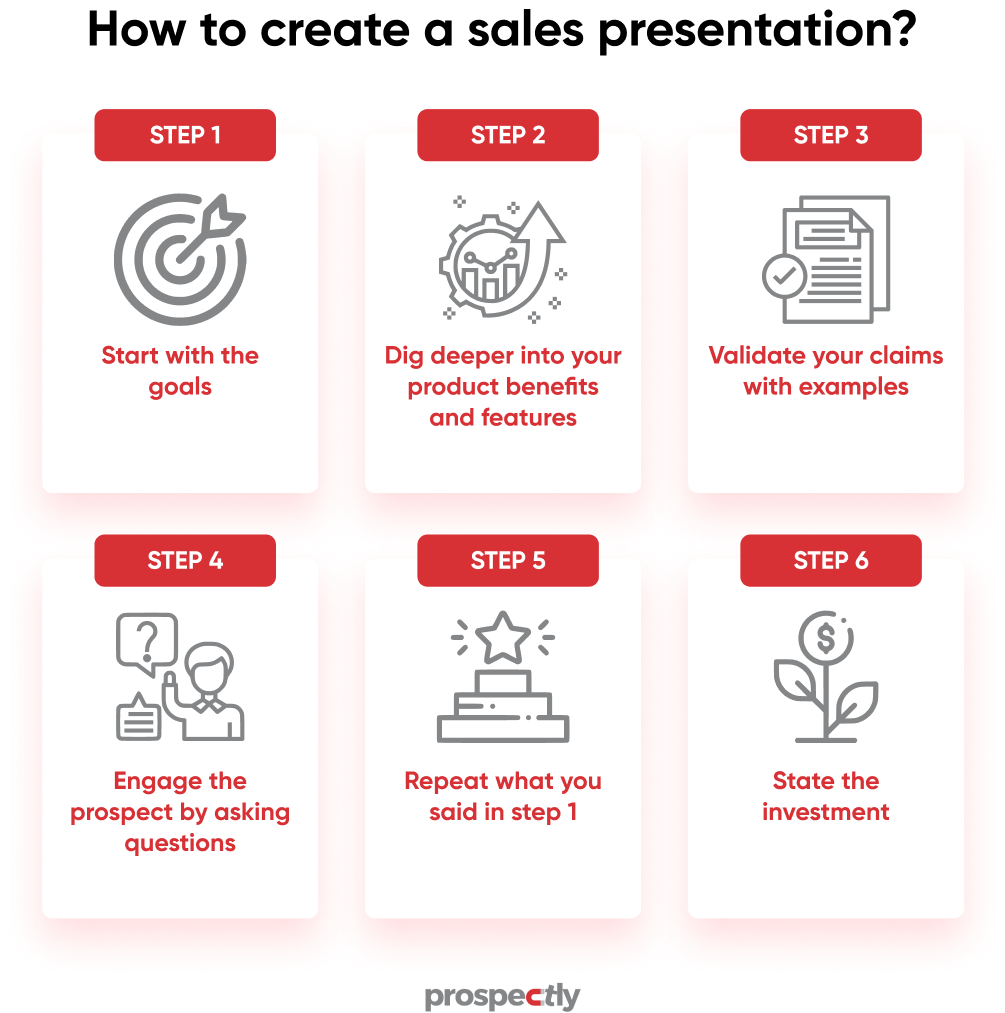
The following sales presentation structure can help you crush your sales.
Step 1: Start with the goals
First, remember that your audience has needs and challenges they want to address. So, start your sales presentation by clarifying the objectives to show that you understand what your prospects need. You could say: “You mentioned your goal was to achieve XYZ.”
You may also list the objectives on the whiteboard or show them in a PowerPoint presentation. Any approach is acceptable as long as you spell out the goals before discussing product benefits. And use the first minutes to say the critical points because people tend to pay maximum attention during the early stages.
Step 2: Dig deeper into your product benefits and features
Step one is now clear. Next, discuss what you offer and how the product features can fix the potential customer’s pain points. Turn the technical aspects of your solution into benefits. Of course, you need to do this before the sales presentation.
Example 1
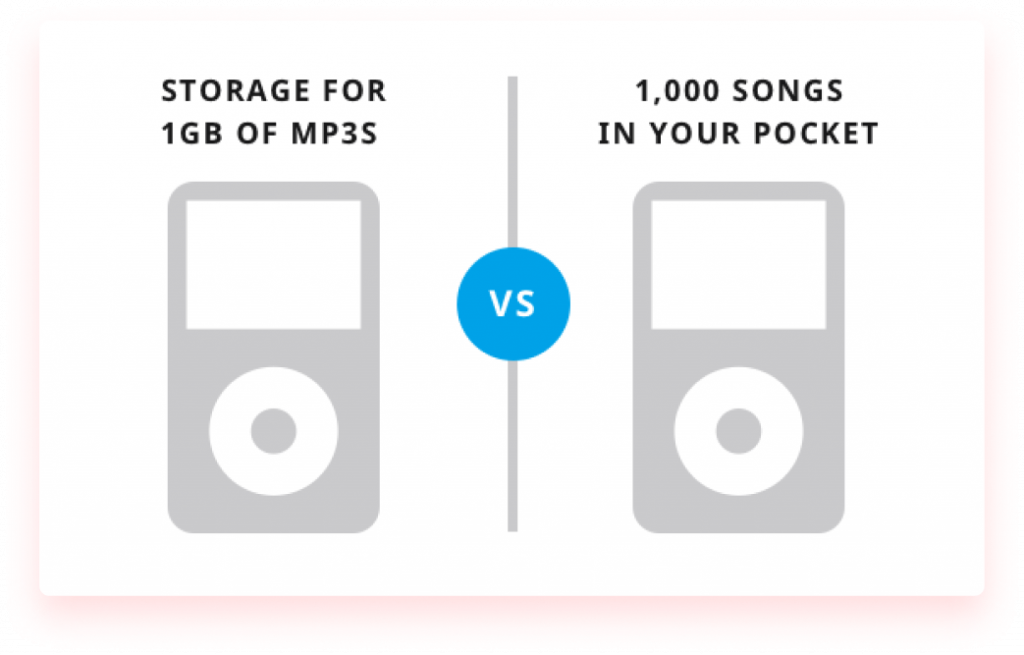
Example 2: Wordstream zeroes in on benefit-based marketing
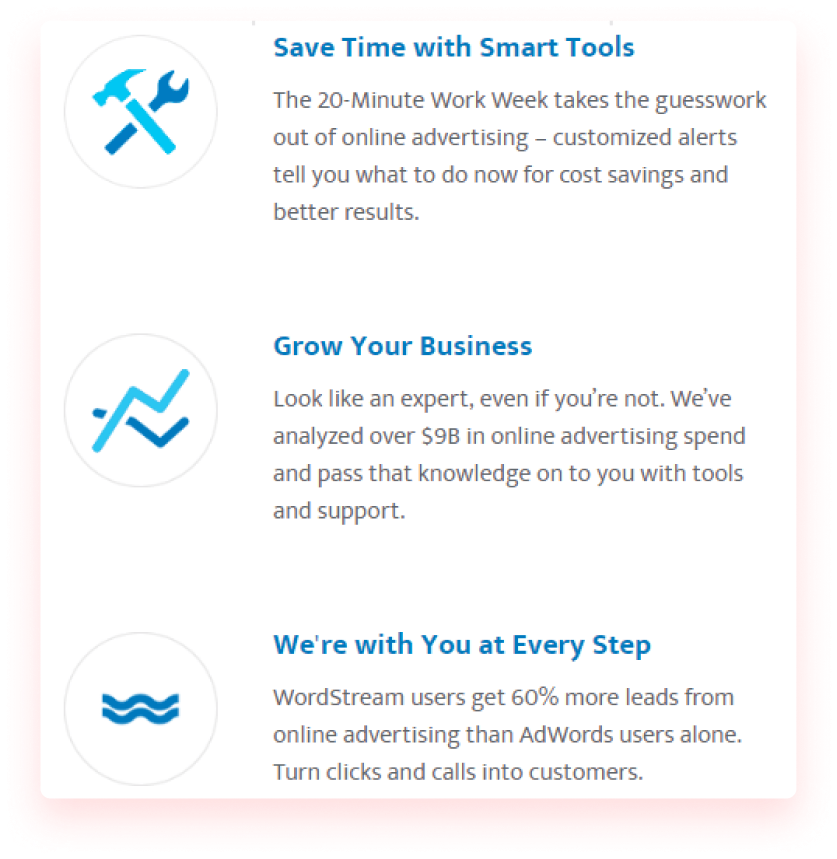
Also, say: “Let me explain how we fix problem B for you, and here is what you benefit from the product.” Ensure you dive into the solution, and the product benefits speak to the customer’s challenges. You can show a demo to strengthen your case.
Step 3: Validate your claims with examples
You should use specific examples to prove that your solution can help the customer with this step. You can highlight case studies about buyers who solved their challenges using your product or service. Demonstrate that you’ve got a solid track record of dealing with the pain points.
Step 4: Engage the prospect by asking questions
One terrible mistake reps make is talking non-stop without asking for feedback from the audience. Marc Wayshak is a sales expert and says:
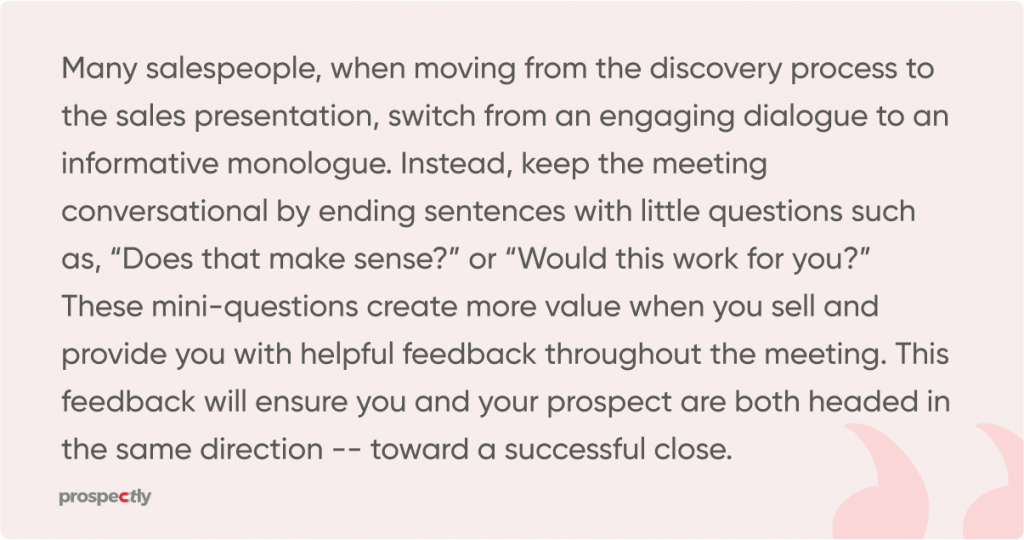
Step 5: Repeat what you said in step 1
Your potential customers are likely to forget most of the things you said. Remind them by rephrasing their challenges and how your solution fixes them. End by saying: “Are there any questions?” Avoid saying, “ My presentation is over or has come to an end” or “Thanks for listening.” Move to the next stage after handling objections, if any.
Step 6: State the investment
It’s now time to say the cost of your product. The best thing is to frame the product price as an investment for the customer. It indicates that they’re making a worthwhile financial decision.
You could say: “ The investment for this product or service is…” After this, ask for the sale – which is your call to action.
11 tips for a top-notch sales presentation
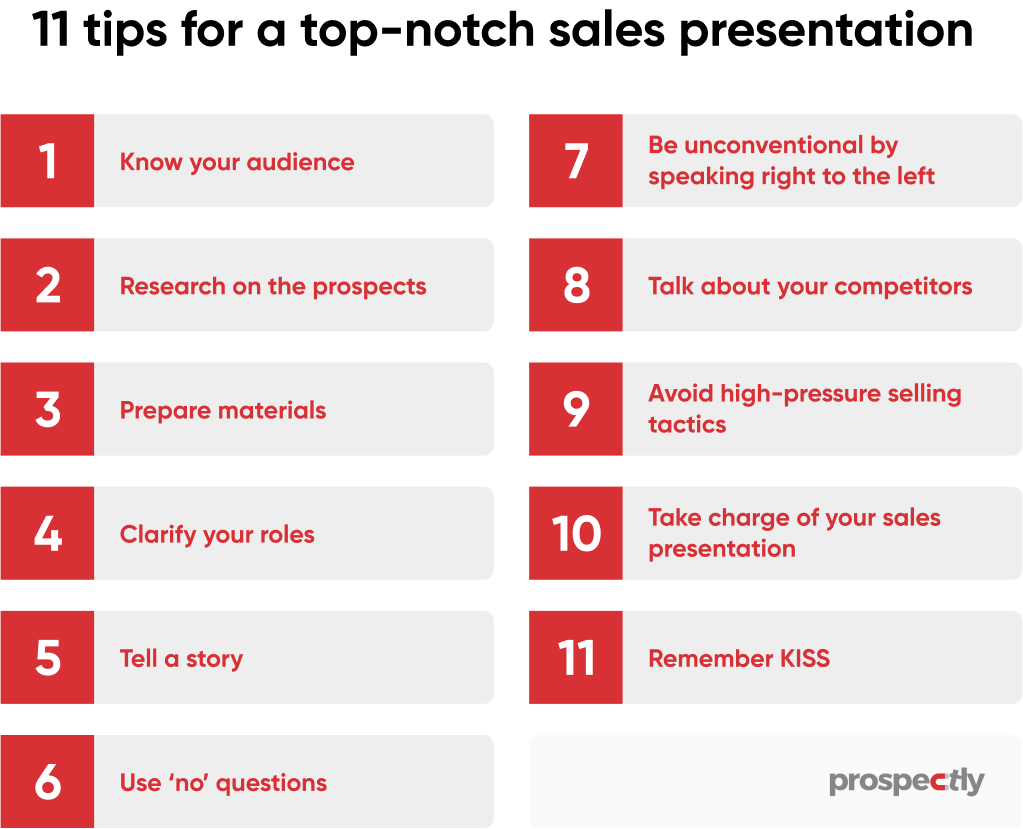
1. Know your audience
You should know the participants of your sales meeting. This way, you can understand what they’re looking for, their needs, and what will interest them the most. You can ask the contact person to provide you with the details to help zero in on what the audience wants.
2. Research on the prospects
The sales presentation isn’t about you – you’re not the session star. The attendees must be front and center of y0ur pitch. Because of this, you need to look up the prospect’s profiles on Google or LinkedIn.
Find out their interests, publications, individual activities, awards, etc. Also, note that some meeting participants may check your online profile. Ensure it’s loaded with professionalism.
3. Prepare materials
Sales presentation hard copies can come in handy after the meeting. They can boost your conversion rate and help you follow up on the conversation. Organize price sheets, digital business cards, brochures, case studies, white paper, press coverage or release, etc.
Also, ensure your handouts have information about who you’re, what you do, how you can help and work with them, and what they must do to do business with your company. Include the price options, the proposed contract terms and conditions, and contact details.
You could convert some documents into an interactive exercise, like a PDF with incomplete sentences. Your listeners can follow along and work on the activities to get engaged.
4. Clarify your roles
Make sure each presenter knows their responsibility before the meeting if it’s a team proposal presentation. Who’ll do what, and when?
5. Tell a story
People like stories that resonate with their experiences. You can grab the audience’s attention and keep them glued by relating a case study of a client you helped. Note that the story should speak to their problems.
Relevant testimonials can develop credibility and trust. Start your story by saying: “I’m going to tell you a story.” It raises a sense of curiosity and expectation.
6. Use ‘no’ questions
Questions requiring yes answers are the most common. However, sales reps need to ask ‘no’ questions to allow the prospect to highlight any missing details in the presentation. You’ll get to know their challenges and how you can close the deal.
Here are examples of closed-ended questions to align your solution with the audience’s pain points. You can tweak them to suit your situation.
–How well do your sales representatives utilize technology?
-Do you think your team should do more of Y?
-Would you say you’ve done your best in [insert area]?
-[Insert problem area] is it a challenge for your company?
Related: 19 Best sales discovery questions to close more deals
7. Be unconventional by speaking right to the left.
According to Sales Hacker, “Everyone has expectations of presentations. Break them. In doing so you can not only help drive engagement but also show that you are in control of the presentation and drive the slides.”
And this is how people expect y0u to present your sales pitch – from left to right or top to bottom. Instead, begin with your central point to encourage your audience to focus on you, not the slides.
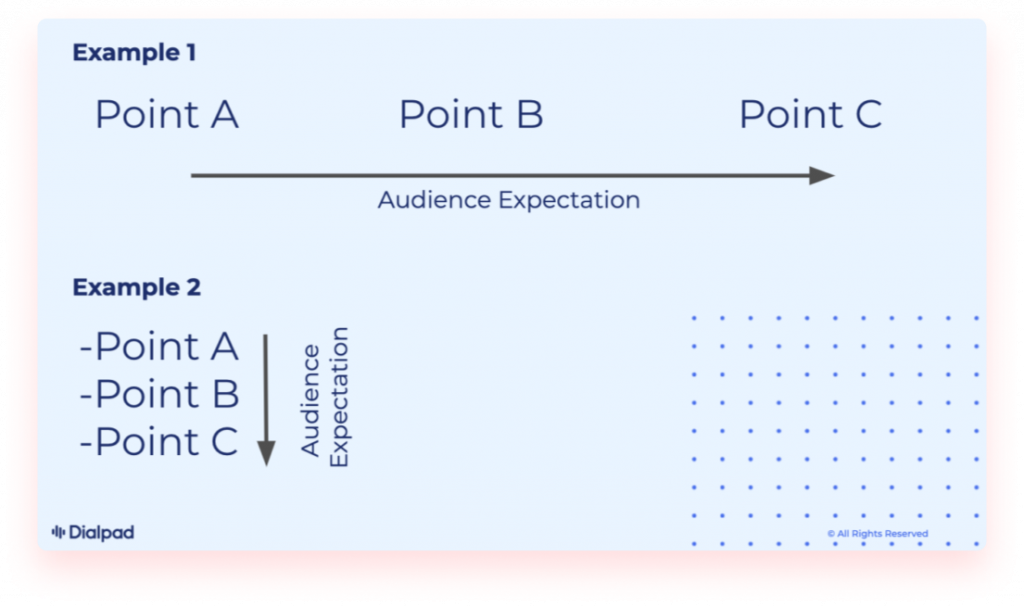
8. Talk about your competitors
Sales reps may think that including product competitors in their proposal presentation is a disadvantage. But discussing the rival’s strengths improves credibility showing your expertise and understanding of the customer’s problems.
Ensure that you demonstrate how your solution is better in fixing the audience’s challenges.
9. Avoid high-pressure selling tactics
A hard sale in your pitch shows that you’re more interested in getting rid of your product instead of helping the buyer. As a result, they can become more resistant. The better approach is guiding them to solve their problem based on their needs and budget.
A satisfied and happy buyer can become your potent evangelist when they tell others how helpful your business is -you win more customers.
10. Take charge of your sales presentation
Want to instill confidence in your delivery and solution? Avoid saying you think your product is the perfect fit for your prospects. Instead, let the attendees know that you trust what you offer by being persuasive and assertive. See the following examples.
Example 1

The above marketing messages include overused and abstract words: ‘productive,’ ‘productivity,’ ‘blow the roof,’’ and ‘blow you away.’ As a result, they’re not persuasive, concrete, emotional, and assertive.
Example 2
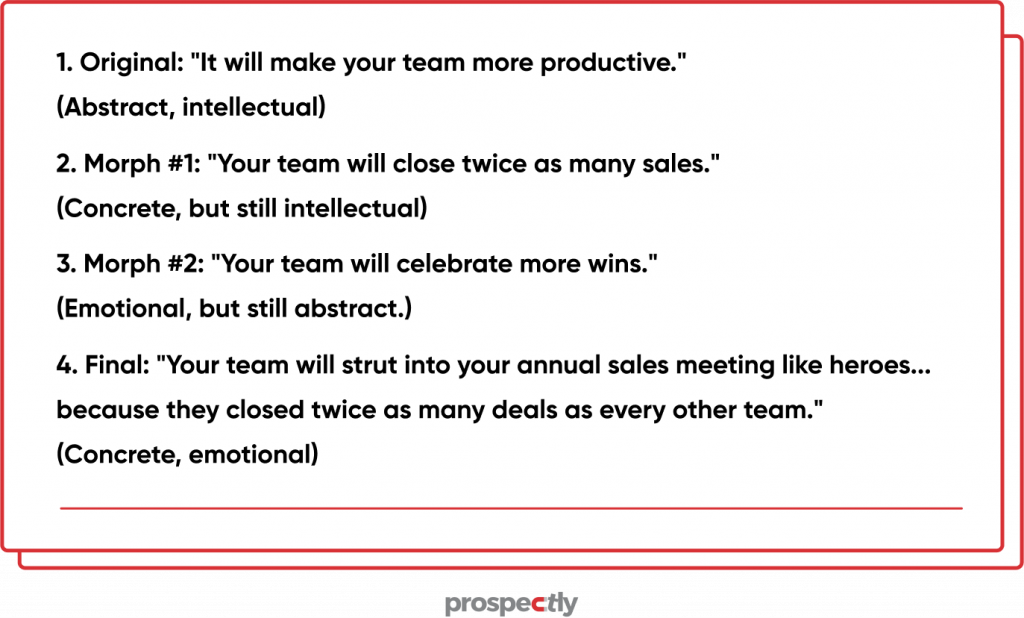
The last sentence is the best persuasive sales message- it’s concrete and emotional. You can also incorporate some statistics to add credibility.
11. Remember KISS
Many sales experts agree that concise sales presentations are the way to go. That’s because humans’ attention span is falling, as some studies claim. Your proposal presentation should follow KISS (Keep It Short & Simple). Or the 9-minute rule – meaning try to say everything in less than 9 minutes by spending between 2-3 minutes per slide.
Sales presentation styles

The following are examples of sales presentation approaches you can adopt in your delivery.
Connector style
As the name suggests, the sales presentation technique is like a two-way street. The presenter encourages the audience to respond to their content through open-ended questions. There’s dialogue, feedback, and active participation to allow the prospects to connect with you.
The visual approach
It’s a style that uses PowerPoint slides to create a powerful visual sales presentation. Sales reps can use this method for large audiences. Also, it’s ideal if you’ve plenty of details you want to discuss. Slides can summarize the info- Visme lets you create different slides for varied listeners.
Freeform style
The technique relies on the salesperson’s skills to deliver a compelling sales pitch. And it leaves slides out of the presentation. You can use the style if you know your pitch inside and out and have little time for longer delivery.
Get inspired by these sales presentation examples
Richter
DemandGen
SalesScripter
Uber for business
Also, watch the following sales presentation videos to get more ideas.
MIT
Mad Men
Summary on what makes a successful sales presentation

Over to you
Sales presentations are a great way to close the deal. Here are critical things you should keep in mind when doing one.
-The first step in preparing for your presentation is identifying your audience, needs, and concerns.
-The second step is to develop an outline that includes key points about how you’ll address these challenges or pain points.
-The third step is to create visuals that’ll help you engage with your audience – these visuals should be clear, concise, and relevant to what you’re trying to say.
-Finally, if you’re presenting in person, you must get into the right mindset by taking deep breaths before starting.
Also, watch the following 3-minute video on how you can give a top-class sales presentation.
Related: How to win buyers and influence revenue with your sales pitch
